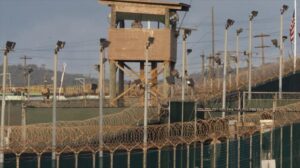
The indefinite, illegal and forcible possession of Guantanamo Bay, in eastern Cuba, is a disastrous vestige of the Permanent Treaty imposed by the United States on the island on May 22, 1903.
Although Washington had already landed his troops in the coveted cove on June 10, 1898, it was the signing of that “agreement” that curtailed national sovereignty by turning the Caribbean nation into a Yankee protectorate.
The Permanent Treaty subordinated very sensitive strategic objectives of Cuba’s politics, economy, international relations and defense to Washington’s designs, and granted it the right to intervene militarily.
Under these conditions and the threat of maintaining the U.S, occupying army, the Cuban Senate approved on June 16, 1903 the lease agreement for land on the island for the establishment of naval stations, the Guantanamo historian, José Sánchez Guerra, says.
The Platt Amendment brought strong populist pressure which led to repeal it in May 1934, but the items related to the naval base remained. The new Relations Treaty between the two countries expressed Washington’s decision to maintain the military presence in the redoubt indefinitely.
The text refers in that section that as long as the military base is not abandoned by the United States or the two parties agree to a modification of its limits, the naval base will continue to have the territorial extension it now occupies, Sánchez explained.
May 29 marked the 89th anniversary of that onerous legal monstrosity considered the last treaty on the permanence of military camp of the US Navy in Guantanamo Bay.
The return of that occupied territory under blackmail and threats is one of the central issues of the historic dispute between the United States governments and the Cuban people. It is an issue that damages the national sovereignty.
COVETED BAY
“They have seen Guantanamo, they will never give up on possessing it,” declared the colonel of the Cuban Liberation Army, Manuel Sanguily, when he knew that US naval units landed in Playa del Este in Caimanera Bay, in the eastern region of the island.
The time and facts have proven that the colonel Sanguily was right. Since June 10, 1898, the United States has never left the strategic military camp.
Five years later, it was awarded in perpetuity as a naval base by virtue of an illegal treaty signed on February 16 under the Tomás Estrada Palma’s government.
The coveted bay has a privileged geographical position, a pocket configuration with deep draft and considerable surface area of its waters.
It is located just 125 kilometers from the Paso de los Vientos, an obligatory maritime route between North and South America, and in a straight line 1,320 kilometers from the Isthmus of Panama, which makes it the best sea sine in the area.
The interest of the nascent northern imperial power for that portion of Cuban soil began to show itself from early times, when the sailors realized that the port of Guantanamo was the safest for navigation among its Caribbean islands.
AGGRESSIONS ON CENTRAL AMERICA AND THE WORLD
From the space occupied on the Cuban island, the White House prepared its marines in 1911 to intervene in Mexico. Additionally, in 1914, President Thomas Woodrow Wilson twice ordered landings of units in Haiti.
In 1916, the command post for the units that landed that year in the Dominican Republic was organized in Guantanamo. Also the forces of the 50th Regiment embarked from there in 1927 to slash the revolution led by General Augusto C. Sandino, in Nicaragua.
The Naval Base was a very important piece in the strategy of the United States in World War II; Some specialists even point out that it became the second port of movement in the world, only surpassed by New York, the Guantanamo historian says.